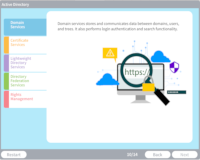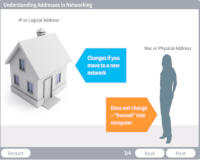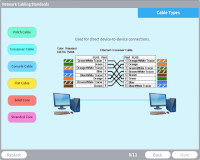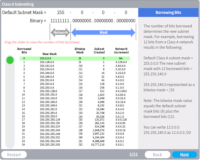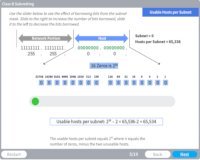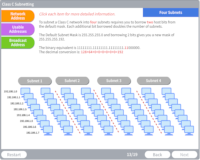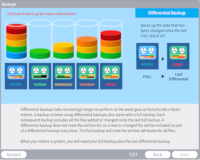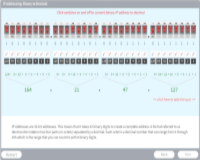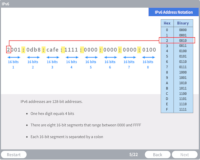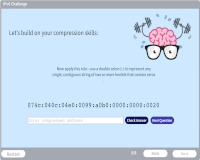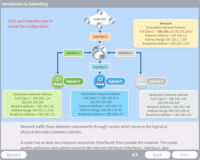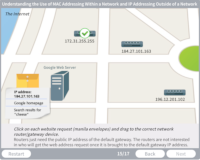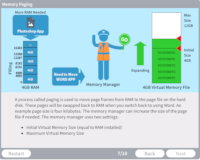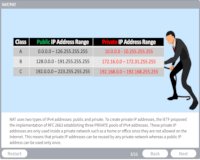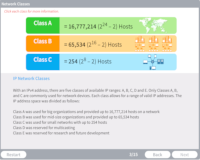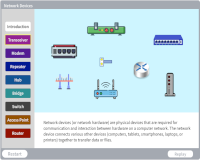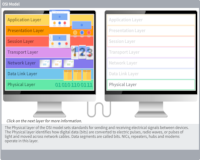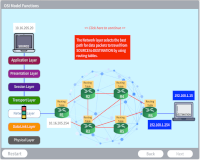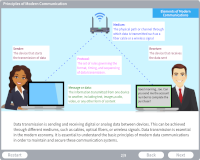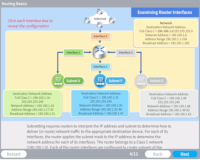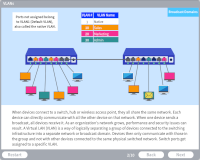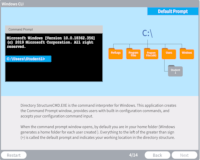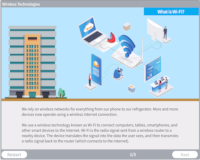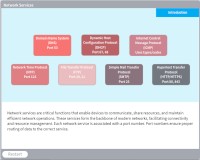Active Directory
Description: Explore the important concepts in managing multiple users and computer resources with Active Directory
Key Words: software, user, resource, Windows, server, network, permission, domain, trust, certificate, LDAP, root, single, rights
Level: High School Community College
Key Words: software, user, resource, Windows, server, network, permission, domain, trust, certificate, LDAP, root, single, rights
Level: High School Community College
Addresses in Networking
Description: Explains the basics of network addressing.
Key Words: Ip, address, network, mac
Level: Middle School High School Community College
Key Words: Ip, address, network, mac
Level: Middle School High School Community College
Class A Subnetting
Description: Explore how to subnet a Class A network.
Key Words: IP, octet, address, subnet, mask, bit, host, network, broadcast, class-A
Level: High School Community College
Key Words: IP, octet, address, subnet, mask, bit, host, network, broadcast, class-A
Level: High School Community College
Class B Subnetting
Description: Explore how to subnet a Class B network.
Key Words: IP, octet, address, subnet, mask, bit, host, network, broadcast, class-B
Level: High School Community College
Key Words: IP, octet, address, subnet, mask, bit, host, network, broadcast, class-B
Level: High School Community College
Class C Subnetting
Description: Explore how to subnet a Class C network.
Key Words: IP, octet, address, subnet, mask, bit, host, network, broadcast, class-C
Level: High School Community College
Key Words: IP, octet, address, subnet, mask, bit, host, network, broadcast, class-C
Level: High School Community College
Digital Media Handling - Backups
Description: Explore the various types of backups.
Key Words: archive, bit, attribute, full, incremental, differential, image, storage, backup
Level: High School Community College
Key Words: archive, bit, attribute, full, incremental, differential, image, storage, backup
Level: High School Community College
File Systems
Description: Explore how a file system organizes and retrieves files. Discover the differences between various file systems.
Key Words: partition, format, windows, Linux, apple, path, metadata
Level: Middle School High School Community College
Key Words: partition, format, windows, Linux, apple, path, metadata
Level: Middle School High School Community College
IP Addressing: Binary to Decimal
Description: Practice converting Ip addresses from binary to decimal.
Key Words: Ip, address, binary, decimal, conversion, dot notation,
Level: High School Community College
Key Words: Ip, address, binary, decimal, conversion, dot notation,
Level: High School Community College
IPv6
Description: Explore how IPv6 IP addresses differ from IPv4.
Key Words: IP, address, hexadecimal, binary, compress, unicast, anycast, multicast, network, subnet, interface
Level: High School Community College
Key Words: IP, address, hexadecimal, binary, compress, unicast, anycast, multicast, network, subnet, interface
Level: High School Community College
IPv6 Challenge
Description: Practice converting IPv6 addresses based on the rules discussed in the IPv6 Emate.
Key Words: IP, address, hexadecimal, binary, compress, unicast, anycast, multicast, network, subnet, interface
Level: High School Community College
Key Words: IP, address, hexadecimal, binary, compress, unicast, anycast, multicast, network, subnet, interface
Level: High School Community College
Introduction to Subnetting
Description: Learn how to subnet Class C networks.
Key Words: network, host, class, subnet, bits, binary, Boolean, magic, power, mask
Level: High School Community College
Key Words: network, host, class, subnet, bits, binary, Boolean, magic, power, mask
Level: High School Community College
MAC Addressing
Description: Understand the use of MAC Addressing within a network and IP Addressing outside of a network.
Key Words: MAC Address, hardware address, physical address, OUI, organizational, unique Identifier
Level: High School Community College
Key Words: MAC Address, hardware address, physical address, OUI, organizational, unique Identifier
Level: High School Community College
Memory Paging
Description: Explore how memory paging works within the Windows operating system.
Key Words: ram, CPU, frame, virtual, system, memory, page, Windows, operating, os
Level: Community College
Key Words: ram, CPU, frame, virtual, system, memory, page, Windows, operating, os
Level: Community College
NAT/PAT
Description: Explore the use of NAT and PAT to hide the real IP address of internal devices and to allow multiple private addresses access to one Internet connection while and conserving IP address space
Key Words: address, port, translation, public, private, IP, class, default, gateway, router, network, multicast
Level: High School Community College
Key Words: address, port, translation, public, private, IP, class, default, gateway, router, network, multicast
Level: High School Community College
Network Classes
Description: Explore the different network classes and how they are used in network addressing.
Key Words: IP, octet, address, subnet, mask, bit, host, network, broadcast, class, C, B, A, D, E
Level: Middle School High School Community College
Key Words: IP, octet, address, subnet, mask, bit, host, network, broadcast, class, C, B, A, D, E
Level: Middle School High School Community College
Network Devices
Description: Learn the various types of devices used on a network.
Key Words: transceiver, modem, repeater, hub, bridge, switch, access point, router, analog, digital, modulate, signal, port
Level: Middle School High School Community College
Key Words: transceiver, modem, repeater, hub, bridge, switch, access point, router, analog, digital, modulate, signal, port
Level: Middle School High School Community College
OSI Model
Description: The OSI model describes a networking framework and how information from a software application in one computer moves through a network to a software application in another computer.
Key Words: application, presentation, session, transport, network, data link, physical, layer, transmit, packet, frame, open system interconnect
Level: High School Community College
Key Words: application, presentation, session, transport, network, data link, physical, layer, transmit, packet, frame, open system interconnect
Level: High School Community College
OSI Model Functions
Description: Describes the use of headers during data encapsulation within the OSI Model framework.
Key Words: encapsulation, layer, framework, tcp, udp, frame, address, rpc
Level: Community College
Key Words: encapsulation, layer, framework, tcp, udp, frame, address, rpc
Level: Community College
OSI Model Fundamentals
Description: Describes the use of headers during data encapsulation within the OSI Model framework.
Key Words: encapsulation, layer, framework, tcp, udp, frame, address, rpc
Level: Community College
Key Words: encapsulation, layer, framework, tcp, udp, frame, address, rpc
Level: Community College
Routing Basics
Description: Learn how routing and subnetting affects the path for traffic in an organization’s network between or across multiple networks.
Key Words: traffic, network, IP address, class, broadcast, subnet, interface, mask, packet, routing, table, distance, protocols, dynamic, static, distance, vector, link, state
Level: Community College
Key Words: traffic, network, IP address, class, broadcast, subnet, interface, mask, packet, routing, table, distance, protocols, dynamic, static, distance, vector, link, state
Level: Community College
VLSM
Description: Learn how to use a VLSM to divide an IP network into more efficient subnets of different sizes.
Key Words: subnet, mask, network, IP address, class, host, variable, length
Level: Middle School High School Community College University
Key Words: subnet, mask, network, IP address, class, host, variable, length
Level: Middle School High School Community College University
VLSM Challenge
Description: Use the information presented in the VLSM Emate to complete the challenge exercises.
Key Words: subnet, mask, network, IP address, class, host, variable, length
Level: Community College
Key Words: subnet, mask, network, IP address, class, host, variable, length
Level: Community College
Windows CLI
Description: Use the command-line Interface (CLI) to enter commands in the form of lines of text to execute commands.
Key Words: operating system, GUI, command, windows, drive, directory, prompt, file, root, path, syntax, Windows
Level: Community College
Key Words: operating system, GUI, command, windows, drive, directory, prompt, file, root, path, syntax, Windows
Level: Community College
Windows Permissions
Description: Use permissions management as a tool to help prevent unauthorized access.
Key Words: share, ntfs, group, user, folder, file, read, privilege, restrict, deny, allow, inherit, Windows
Level: Community College
Key Words: share, ntfs, group, user, folder, file, read, privilege, restrict, deny, allow, inherit, Windows
Level: Community College
Wireless Technologies
Description: Explore how wireless technology enables communication between two or more devices over distances without the use of wires or cables by using radio frequency (RF) and infrared (IR) waves.
Key Words: wpa, wep, ssid, wifi, cellular, transmission, speed, frequency, capacity, 802.11, 802.15, 802.16, Bluetooth, band, zigbee, zwave, wsn, ieee
Level: High School Community College
Key Words: wpa, wep, ssid, wifi, cellular, transmission, speed, frequency, capacity, 802.11, 802.15, 802.16, Bluetooth, band, zigbee, zwave, wsn, ieee
Level: High School Community College
Wireless Technologies w/Narration
Description: Narrated version of the Wireless Technologies Emate
Key Words: wpa, wep, ssid, wifi, cellular, transmission, speed, frequency, capacity, 802.11, 802.15, 802.16, bluetooth, band, zigbee, zwave, wsn, ieee
Level: High School Community College
Key Words: wpa, wep, ssid, wifi, cellular, transmission, speed, frequency, capacity, 802.11, 802.15, 802.16, bluetooth, band, zigbee, zwave, wsn, ieee
Level: High School Community College
Virtual LAN (VLAN)
Description: Explore how VLANs work, how VLANs are set up, and the benefits of a VLAN
Key Words: vlan, native, switch, broadcast, mac, port, address, static, dynamic, trunk, tag, 802.1q, routing
Level: High School Community College
Key Words: vlan, native, switch, broadcast, mac, port, address, static, dynamic, trunk, tag, 802.1q, routing
Level: High School Community College
Principles of Modern Communication
Description: Understand the basic principles of modern data communications in order to maintain and secure these communication systems
Key Words: analog, digital, signals, multiplexer, media, channel, transmit, cast, broadband, baseband, synchronous, asynchronous, ethernet, frame, transmission, topology, ring, star, bus
Level: High School Community College
Key Words: analog, digital, signals, multiplexer, media, channel, transmit, cast, broadband, baseband, synchronous, asynchronous, ethernet, frame, transmission, topology, ring, star, bus
Level: High School Community College
Cabling Standards
Description: Differentiate Ethernet cables based on type, properties, and application
Key Words: cable, cat, bandwidth, speed, shield, environment, emi, interference, gauge, wire, twist, color, standard, console, patch, crossover, flat, core, plenum, riser, poe
Level: High School Community College
Key Words: cable, cat, bandwidth, speed, shield, environment, emi, interference, gauge, wire, twist, color, standard, console, patch, crossover, flat, core, plenum, riser, poe
Level: High School Community College
Network Services
Description: Explore several network services
Key Words: domain, protocol, dns, dhcp, imcp, smtp, email, server, service, network, ftp, name, host, time, nap, web, http, https
Level: High School Community College
Key Words: domain, protocol, dns, dhcp, imcp, smtp, email, server, service, network, ftp, name, host, time, nap, web, http, https
Level: High School Community College


